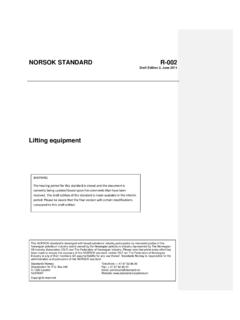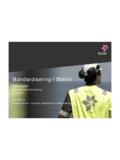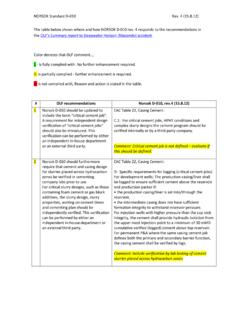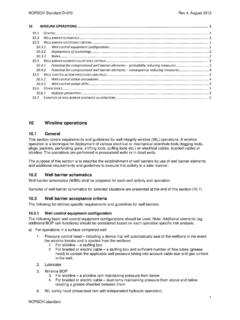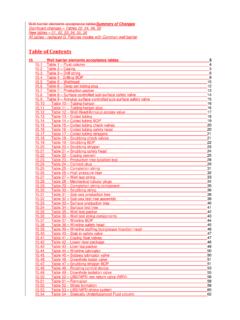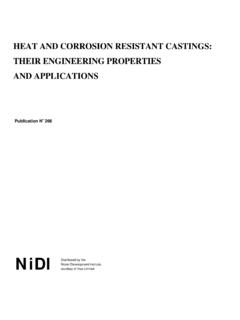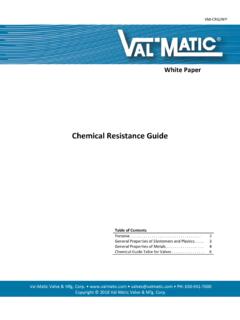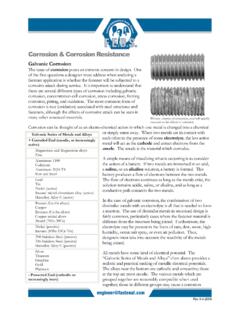Transcription of NORSOK STANDARD M-001
1 This NORSOK STANDARD is developed by NTS with broad industry participation. Please note that whilst every efforthas been made to ensure the accuracy of this STANDARD , neither OLF nor TBL or any of their members will assumeliability for any use thereof. NTS is responsible for the administration and publication of this Technology CentreTelephone: + 47 22 59 01 00 Oscarsgt. 20, Postbox 7072 MajorstuenFax: + 47 22 59 01 29N-0306 OsloEmail: reservedNORSOK STANDARDM-001 Rev. 3, Nov. 2002 Materials selectionNORSOK STANDARD M-001 Rev. 3, Nov. 2002 NORSOK standardPage 1 of 30 Foreword2 Introduction21 Scope32 Normative references33 Definitions and principles for material selection and corrosion and corrosion monitoring115 Material selection for specific production and flowline and mooring lines for floating units236 Design limitations for candidate for structural for pressure retaining materials287 Qualification of materials and programmes for fabrication contractors30 NORSOK STANDARD M-001 Rev.
2 3, Nov. 2002 NORSOK standardPage 2 of 30 ForewordThe NORSOK standards are developed by the Norwegian petroleum industry to ensure adequate safety,value adding and cost effectiveness for existing and future petroleum industry NORSOK standards are prepared to complement available international standards and fill the broadneeds of the Norwegian petroleum industry. Where relevant NORSOK standards will be used to provide theNorwegian industry input to the international standardisation process. Subject to development andpublication of international standards, the relevant NORSOK STANDARD will be standards are developed according to the consensus principle generally applicable for moststandards work and according to established procedures defined in NORSOK A-001 The preparation and publication of the NORSOK standards is supported by OLF (The Norwegian OilIndustry Association) and TBL (Federation of Norwegian Manufacturing Industries).
3 NORSOK standards areadministered and issued by NTS (Norwegian Technology Centre).IntroductionThe provisions of this NORSOK STANDARD are intended to comply with the requirements of the EC PressureEquipment Directive and the Norwegian implementation regulation Forskrift for trykkp kjent utstyr issued 9 June 1999. When this STANDARD refers to the PED only, it is implicit that it also refers to the Norwegianimplementation requirements given for materials by PED in its Annex I Essential Safety Requirements section , arebasically fulfilled provided the principles of material selection of this NORSOK STANDARD are followed documentation requirement in PED Annex I section of the materials used in main pressure retainingparts of equipment in PED categories II, III and IV, must take the form of a certificate of specific productcontrol. This is fulfilled by the certification requirement given by the Material Data Sheets compiled inNORSOK PED requirements to specific material characteristics given in its Annex I section , are as follows: A steel is considered sufficient ductile if the elongation before rupture in a tensile test carried out by astandard procedure is not less than 14 %.
4 The measured absorbed impact energy on an ISO V-notch test shall not be less than 27 J at the lowestscheduled operating the material grades given in the materials selection tables in this NORSOK STANDARD and specified by theMDS compiled in NORSOK M-630 fulfil the material characteristics and documentation requirementsspecified by PED to piping category III, except the CMn-steel Type 235 defined by MDS C01 and C02, whichin the current revision has no requirement to impact PED requires that the manufacturer provide documentation of elements relating to compliance with thematerial specifications of the Directive in one of the following forms: By using materials which comply with a harmonised European STANDARD By using materials covered by a European approval of materials (EAM) By a particular material appraisal (PMA).The materials standards used in NORSOK Piping and Valve STANDARD L-001 are not based on harmonisedEuropean standards or given an EAM.
5 Therefore, a particular appraisal has to be made to confirmcompliance to PED for each particular STANDARD M-001 Rev. 3, Nov. 2002 NORSOK standardPage 3 of 301 ScopeThe scope of this STANDARD is to provide general principles, engineering guidance and requirements formaterial selection and corrosion protection for all parts of offshore document gives guidance and requirements for: corrosion and material selection evaluations. Specific material selection where appropriate. corrosion protection. Design limitations for candidate materials. Qualification requirements for new materials or new Normative referencesThe following standards include provisions which, through reference in this text, constitute provisions of thisNORSOK STANDARD . Latest issue of the references shall be used unless otherwise agreed. Other recognizedstandards may be used provided it can be shown that they meet or exceed the requirements of thestandards referenced RP 17 JSpecification for unbonded Flexible B A 193 Specification for Alloy-Steel and Stainless Steel Bolting Materials for High- A 194 Specification for Carbon and Alloy Steel Nuts for Bolts for High-Pressure and High-Temperature A 320 Specification for Alloy Steel Bolting Materials for Low-Temperature D 2992 Practice for Obtaining Hydrostatic or Pressure Design Basis for Fibreglass Pipe MA 18 Salt Water Piping in Norske Veritas Guidelines for Flexible Pipes, RP B201 Metallic Materials in Drilling, Production and Process RP O501 Erosive wear in piping OS F101 Submarine Pipeline Equipment Directive, 97/23/ECEFC Publ.
6 No. 16 Guidelines on Material Requirements for Carbon and Low Alloy Steels for H2 SEnvironments in Oil and Gas Publ. no. 17 corrosion Resistant Alloys for Oil and Gas Production. Guidance on GeneralRequirements and Test Methods for H2S 898 Mechanical properties of 13628 - 2 Petroleum and natural gas industries Design and operation of subsea productionsystems Part 2: Flexible pipe systems for subsea and marine 14692 Glass reinforced plastics (GRP) piping - Part 1: Application and materials,- Part 2: Qualification and manufacture- Part 3: System design- Part 4: Fabrication, installation and operationMTI Manual No. 3 Guideline Information on Newer Wrought Iron and Nickel-base corrosion ResistantAlloys, Phase 1, corrosion Test Methods. (Appendix B, Method MTI-2).NACE MR0175 Sulphide Stress Cracking Resistant Metallic Materials for Oilfield Equipment. (Will besuperseded by ISO 15156.)
7 NS 3420 Beskrivelsestekster for bygg og anlegg (Specification texts for building andconstruction).NS 3473 Concrete Structures. Design STANDARD M-001 Rev. 3, Nov. 2002 NORSOK standardPage 4 of 30 NORSOK Standards:L-001 Piping and ValvesM-101 Structural Steel FabricationM-120 Material Data Sheets for Structural SteelM-121 Aluminium Structural MaterialsM-501 Surface Preparation and Protective CoatingM-503 Cathodic Protection DesignM-506CO2 corrosion rate calculation modelM-601 Welding and Inspection of PipingM-CR-621 GRP Piping Materials (will be renumbered M-621)M-630 Material Data Sheets for PipingM-650 Qualification of Manufacturers of Special MaterialsM-710 Qualification of Non-metallic Sealing Materials and Manufacturers3 Definitions and DefinitionsC- glassA special fibre type that is used for its chemical stability in form used for statements of possibility and capability, whether material,physical or general purpose fibre that is most used in reinforced modified E-glass fibre type with improved corrosion resistance against machining steelSteel to which elements such as sulphur, selenium, or lead have been addedintentionally to improve operatingtemperatureThe temperature in the equipment when the plant operates at unstableconditions, like control requirements.
8 Process flexibility and process form used to indicate a course of action permissible within the limits of temperatureThe temperature in the equipment when the plant operates at steady statecondition, subject to normal variation in operating equivalentppb oxygen + x ppb free Pressure Equipment DirectivepH stabilisationIncrease in bulk pH to reduce corrosion in condensing water resistance Equivalent,PRE = % chromium + x % Molybdenum + 16 x % form used to indicate requirements strictly to be followed in order toconform to the STANDARD and from which no deviation is permitted, unlessaccepted by all involved form used to indicate that among several possibilities one isrecommended as particularly suitable, without mentioning or excluding others, orthat a certain action is preferred but not necessarily STANDARD M-001 Rev. 3, Nov. 2002 NORSOK standardPage 5 of 30 Definitions of descriptors used for metallic materials in this document are given in the table MaterialsGeneric typeUNST ypical alloy composition% Cr% Ni% MoothersCarbon and low alloy stainless steels13Cr1313Cr 4Ni134SM13Cr1262C< - 4 PHS17400174 austenitic stainless < , N= min.
9 Stainless base alloysAlloy 718N0771819533Nb=5 Alloy 800H/Alloy 800 HTN08810 /N088112133-Al + TiAlloy 825N0882521423 TiCo-base alloysElgiloyR3000320167Co=40MP-35-NR300 35203510Ti, Co base alloysCu-Ni 90-10C70600-10-Fe, Cu 70-30C71500-31-Fe, Cu , Fe, Mn,Cu metalC90500---10Sn, Zn,Cu grade 2R50400---C max max max max max 1: This material does not comply with PED-requirements concerning documentation of impact toughness if specified according toNORSOK M-630 NORSOK STANDARD M-001 Rev. 3, Nov. 2002 NORSOK standardPage 6 of AbbreviationsAFFFA queous Film Forming Welding Resistant induced stress corrosion Tip Opening Federation of fibre Reinforced affected Data Technology Institute of the Chemical Process Pressure Equipment material resistance stress Minimum Yield Numbering General principles for material selection and corrosion Material selectionMaterial selection shall be optimised, considering investment and operational/maintenance costs, such thatoverall costs are minimised while providing acceptable safety and reliability.
10 As a minimum, the followingshall be considered: Corrosivity, taking into account specified operating conditions including start up and shut-downconditions. Design life and system availability requirements. Failure probabilities, failure modes and failure consequences for human health, environment, safety andmaterial assets. Inspection and corrosion monitoring the final materials selection the following additional factors shall be included in the evaluation: Priority shall be given to materials with good market availability and documented fabrication and serviceperformance. The number of different materials shall be minimised considering stock, costs, interchangeability andavailability of relevant spare from materials selections specified in this STANDARD may be implemented if an overall cost, safetyand reliability evaluation shows the alternative to be more beneficial.
